Flight Board Hydrofoil: Transforming Kiteboarding
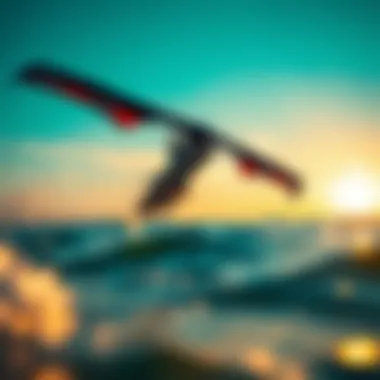
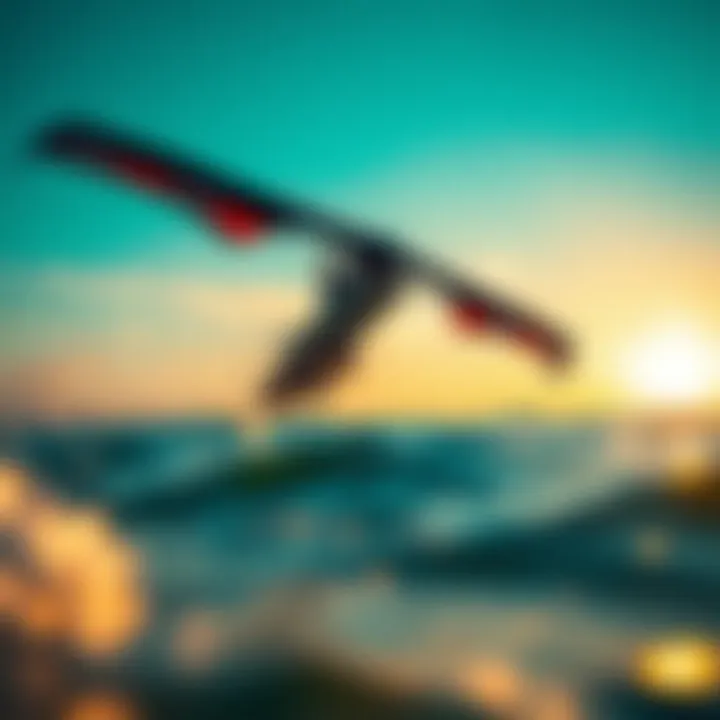
Intro
Kiteboarding has been through its fair share of transformations over the years, but perhaps none quite as revolutionary as the surge of hydrofoil technology. The fusion of kiteboarding and hydrofoiling has led to an exhilarating experience on the water, allowing riders to literally rise above the surface. In this exploration, we’ll dive into the nitty-gritty of flight board hydrofoils, peeling back the layers to reveal the mechanics that make this technology not just a trend, but a fundamental shift in the way enthusiasts engage with the sport.
Hydrofoils, with their elegant design and fine-tuned engineering, change the dynamics of kiteboarding entirely. With that in mind, this piece aims to provide a comprehensive understanding of flight board hydrofoils. From the essential gear required for both new and seasoned riders to safety practices and technique enhancements, we’ll cover it all. Whether you are just starting out or you’ve already logged countless hours on the water, there’s something here for everyone.
Gear and Equipment
Essential Kiteboarding Gear for Beginners
If you’re dipping your toes into kiteboarding with a hydrofoil, it's key to choose the right gear. For newcomers, starting with the basics is a wise move. Here’s a rundown:
- Kite: Opt for a versatile and user-friendly kite. A larger kite offers more lift, which is great for getting off the water more easily.
- Board: The flight board itself should be specifically designed for hydrofoiling. Look for a stable platform that provides ample surface area for balance.
- Straps and Bindings: Ensure these fit well to avoid slippage. Comfort and security can prevent accidents during those exhilarating moments riding high above the waves.
When shopping, spend time trying out different boards to find one that suits your style. Don’t rush the process—this is about finding harmony with your equipment.
Advanced Equipment for Experienced Riders
Once you’ve got a handle on the basics, it might be time to step it up a notch. For more experienced kiteboarders looking to dabble in hydrofoiling, consider these advanced options:
- High-Aspect Ratio Foils: These provide better lift and efficiency, especially at higher speeds. They will help you carve through water like a hot knife through butter.
- Adjustable Foil Systems: Flexibility with the foil setup can adapt to different conditions on the water, so you’re always geared for success.
- Carbon Fiber Boards: They are lightweight and super responsive. A carbon board can take your performance up a notch while maintaining stability.
In the end, the choice of gear can significantly influence your riding experience. It’s not just about functionality; it's about finding a connection with your equipment and enjoying the ride.
"Kiteboarding with a hydrofoil is not merely about speed; it's an artful blend of skill, technology, and nature."
Techniques and Tips
As you step into the world of hydrofoiling, understanding the nuances of riding techniques is vital.
Safety Practices for Kiteboarding
Safety should always come first. Here are basic practices:
- Wear a Life Jacket: Even if you’re a great swimmer, this can just be a lifesaver.
- Know the Wind Conditions: Be aware of the wind patterns and avoid kiting in extreme conditions.
- Keep Distance from Other Riders: This helps prevent collisions, which can turn a fun day into a trip to the hospital.
Training Techniques to Improve Your Skills
To elevate your kitesurfing to new heights, practical training becomes paramount. Focus on:
- Balance Drills: Practice off-water techniques, such as balancing on a slackline or balance board. This strengthens your core and improves overall stability.
- Turns and Transitions: Familiarize yourself with the art of shifting your body weight while turning. It will be fundamental when you glide above the water.
- Consistency: Regular practice is essential. The more time windows you spend on the water, the more skilled you'll become.
With hydrofoiling, the thrill lies in both the rush of flying above the waves and the learning that accompanies it. This fleeting yet mesmerizing experience will leave you hungry for more.
Future Outlook
Hydrofoiling is not just a phase in the kiteboarding world. As technology evolves, so too will the designs and materials of hydrofoils. Innovations such as smart materials that optimize performance or advanced tracking systems might soon be just around the corner. Keeping an eye on industry trends is wise for enthusiasts eager to stay ahead of the curve.
The excitement surrounding flight board hydrofoils is palpable. As this sport continues to develop, there's never been a better time to get involved, whether you're a rookie or a seasoned rider.
For more comprehensive guidelines on kiteboarding and hydroflying techniques, check resources from Wikipedia or community insights on Reddit.
Understanding Hydrofoil Technology
Hydrofoil technology marks a significant leap in the dynamics of kiteboarding, blending the thrill of riding with scientific innovation. Kiteboarding enthusiasts and adventure seekers alike are drawn to this technology not just for its performance but also for the transformation it introduces to the riding experience. The combination of hydrodynamics and aerodynamics in hydrofoils enhances performance while ensuring heightened maneuverability, making this topic crucial for anyone looking to explore the frontiers of kiteboarding.
The art of hydrofoiling is not simply about having a board that glides above water; it's rooted in understanding how lift and drag interact in a fluid context. This understanding not only elevates the experience but also allows for a more detailed exploration of riding techniques that cater to varied wind conditions and personal preferences.
Mechanical Principles of Hydrofoils
At its core, hydrofoil technology operates on fundamental mechanical principles that govern how the board interacts with the water. When a hydrofoil is in motion, it disrupts the water's surface, creating a pressure differential that lifts the board above the water. This lift is influenced by several factors, including the shape of the foil, the angle of attack, and the speed at which the board travels.
- Lift Generation: As the speed increases; the wings of the foil create lift, allowing riders to ascend above water. This lift is comparable to how airplane wings operate, utilizing Bernoulli's principle to enhance performance.
- Drag Minimization: A properly designed hydrofoil minimizes drag, allowing riders to maintain speed even in less-than-ideal conditions. This is crucial, especially for kiteboarding, where wind conditions can fluctuate dramatically.
- Balance and Control: Understanding how to balance effectively on a hydrofoil is perhaps the most challenging aspect for riders. Riders must adjust their body weight and position, especially when making turns or riding over choppy waters, to ensure stability.
The essence of hydrofoiling is learning to harness these mechanical principles. Mastering them can lead to a more enjoyable and exhilarating experience on the water, whether one is a beginner or a seasoned pro.
Components of Flight Boards
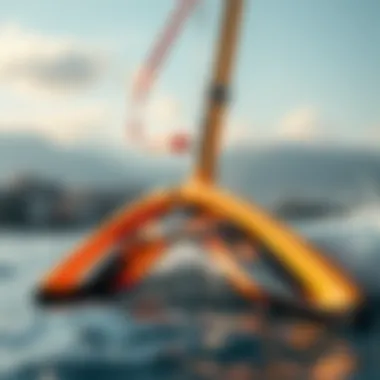
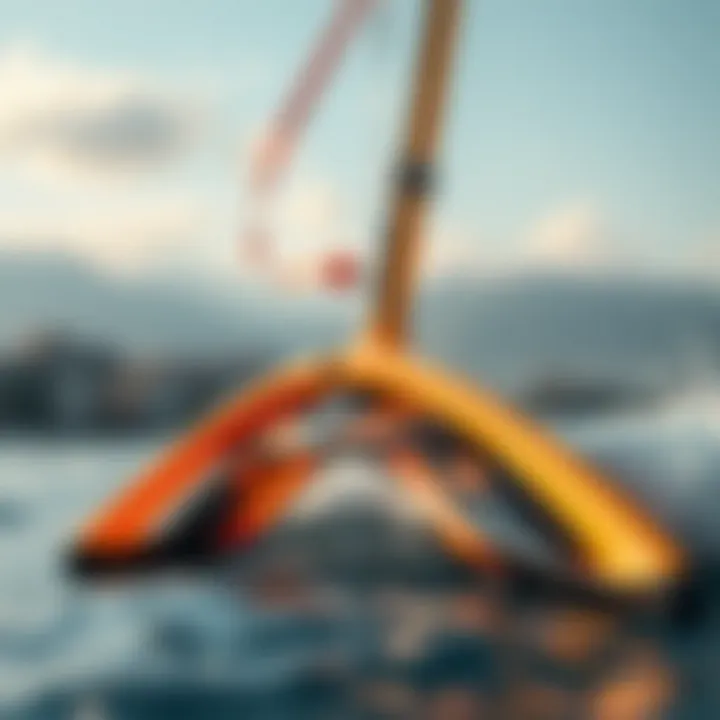
Understanding the components of flight boards is essential for anyone invested in kiteboarding with hydrofoil technology. A hydrofoil board consists of several critical elements, each playing a vital role in performance and functionality. The main components include:
- The Board: Typically wider and longer than traditional boards, flight boards are designed to accommodate the hydrofoils and provide stability during rides.
- The Hydrofoil: The centerpiece of hydrofoil technology, it consists of wings and a fuselage. The wings are shaped to maximize lift while minimizing drag, and the fuselage connects the wings to the mast, which extends downward into the water.
- Mast and Fuselage: The mast raises the foil above the board, enabling it to generate lift. The fuselage connects the mast to the wings in a manner that optimizes stability.
- Bindings: Securely fastening the rider's feet to the board, bindings ensure that the rider maintains their balance while maneuvering and performing tricks.
- Fin: Some boards may also incorporate a fin to provide additional traction in the water, aiding during takeoffs and landings.
Each element intertwines with the others to create a cohesive product that shifts the dynamics of kiteboarding, allowing for a unique experience depending on rider skill level and preferences.
"The beauty of hydrofoil technology is not just in what it does, but in the mastery it requires from each rider. Understanding your equipment turns adventure into an art form.”
As kiteboarders dive into hydrofoil technology, grasping these components and principles not only equips them with practical knowledge but also deepens their connection to the sport, paving the way for enhanced enjoyment and exploration.
The Evolution of Kiteboarding
The evolution of kiteboarding reflects not only the progression of technology but also the ever-changing dynamics of the sport itself. From its nascent stages, where improvised setups were the norm, kiteboarding has transformed into a sophisticated sport, complete with advanced gear that enhances performance and safety. This section elaborates on the historical context of kiteboarding and the significant impact hydrofoiling has made in transforming the experience of riders.
Historical Context of Kiteboarding
Kiteboarding, at its core, is an offshoot of kite flying and surfing, both of which have their own rich histories. The origins trace back to around the late 1970s and early 1980s when innovators began experimenting with concepts of combining kite power with surfboards. Early practitioners utilized modified kites and surfboards, relying on trial and error to find their footing. The sport started gaining traction in the 1990s when equipment began to see more focused development.
During this era, the introduction of the traction kite, which allowed riders to harness more power from the wind, marked a turning point. Kitesurfing, as it was initially called, became popular along coastlines, attracting a community that was eager to push boundaries. As advancements in material technology led to lighter, more durable kites, participants noticed significant improvements in performance.
The inclusion of twin-tip boards further enhanced accessibility, allowing newcomers to learn how to ride quickly. This marked a pivotal shift—it opened the sport up to a wider audience, not just seasoned surfers. With events and competitions emerging, kiteboarding solidified its place in the adventure sport hierarchy. The rising wave of interest propelled into the 21st century, initiating a search for newer methods and experiences.
Kiteboarding evolved from simple homemade setups to the refined equipment we see today, showcasing the relentless push of innovation.
Impact of Hydrofoiling on the Sport
The introduction of hydrofoiling into kiteboarding was akin to fitting a rocket onto an already high-flying bird. Hydrofoils dramatically altered how riders interacted with the water. For many, it was a game changer; it offered an entirely new sensation of flying above the surface. Riders no longer just skimmed the water but soared gracefully, which opened the door to exploring underutilized wind conditions and challenging water conditions that were previously considered unrideable.
The ability to ride smoothly over choppy waters and even experience a sensation akin to flying has contributed to broader appeal of the sport. It connected with thrill-seekers and those eager to engage in a new form of water adventure.
Several benefits come with this technological shift:
- Increased speed and efficiency: Hydrofoils allow riders to reach speeds that were unattainable with traditional boards, opening up opportunities for new tricks and maneuvers.
- Riding in lighter winds allows for longer sessions, reducing the frustration often faced when conditions aren't ideal.
- Enhanced stability underfoot makes for more enjoyable rides, which is particularly encouraging for beginners eager to try hydrofoil boards.
"Hydrofoiling takes our sport to a new level. It’s not just about riding; it’s about experiencing the wind and water in a way that's unlike anything else."
In summary, the evolution of kiteboarding, combined with the advent of hydrofoil technology, has created a new paradigm for riders. This has not only expanded the scope of the sport but also enriched the experience, bringing both depth and enjoyment to adventurers seeking more than just surface-level thrills. As we move forward, understanding these developments lays the groundwork for tackling other aspects of hydrofoiling in kiteboarding.
Advantages of Using Hydrofoil Boards
Hydrofoil boards represent a significant leap in the kiteboarding experience, providing distinct advantages that can redefine how riders engage with the sport. Understanding these benefits is pivotal for anyone keen on elevating their kiteboarding skills. The following sections explore three crucial advantages: increased speed and performance, enhanced maneuverability, and the ability to ride in light winds.
Increased Speed and Performance
One of the standout features of hydrofoil boards is their remarkable ability to increase speed. When the board is lifted above the water’s surface, it reduces drag significantly. This phenomenon allows riders to slice through waves with less resistance, akin to a hot knife through butter. Riders can achieve elevated top speeds that are often unattainable with traditional boards.
Additionally, the lift generated by the hydrofoil creates a smoother ride, allowing for faster acceleration. Many riders report that they feel like they’re flying instead of just skimming the surface; such a sensation adds a layer of dynamism to the experience.
To illustrate this further, consider a comparison between a standard kiteboard and its hydrofoil counterpart. A traditional board might struggle on choppy waters, but the hydrofoil elegantly navigates these conditions, harnessing more wind energy for propulsion.
This greater speed not only exhilarates but also enables kiteboarders to conquer longer distances effortlessly.
Enhanced Maneuverability
A hydrofoil board transforms the essence of turning and maneuvering on the water. The elevated position allows for sharper turns and quicker directional changes, making it an ideal choice for freestyle maneuvers. The leverage provided by the foil can help riders carve through turns that would be taxing for traditional boards.
Moreover, the feedback from the foil provides a unique connection to the water, enhancing control and responsiveness. Riders can execute tricks or adjust their path with surprising ease, all thanks to the reduced drag and buoyancy. Let's not forget that this also allows for great performance in various water conditions.
However, with this increased maneuverability comes the need for precision and skill. Riders must develop a keen sense of anticipation and balance to maximize the benefits. Proper technique and practice become imperative when navigating sharp turns or rapid changes in direction.
Riding in Light Winds
One of the most frustrating experiences for kiteboarders is grappling with insufficient wind. Traditional boards often struggle in light wind conditions, leading to a longing for stronger gusts. Yet this is where hydrofoil boards shine brightly in the niche they occupy.
Thanks to their unique design, they allow riders to take full advantage of the slightest wind—often enabling rides even when the breeze barely whispers. With the hydrofoil lifting the board off the water, less wind is needed to create lift. Riders can look forward to sessions where they can catch epic rides in conditions other boarders would dismiss.
Operating a Flight Board Hydrofoil
Operating a flight board hydrofoil can be a game changer in the kiteboarding landscape. This technology brings about a unique blend of speed and exhilaration, making the entire experience not only thrilling but also more efficient. To truly harness the capabilities of a hydrofoil, kiteboarders need to be well-versed in several aspects of operation. These include mastering proper riding techniques, making necessary adjustments to the board, and being aware of common pitfalls that could detract from the experience.
Proper Techniques for Riding
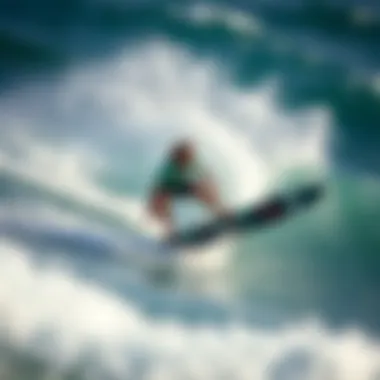
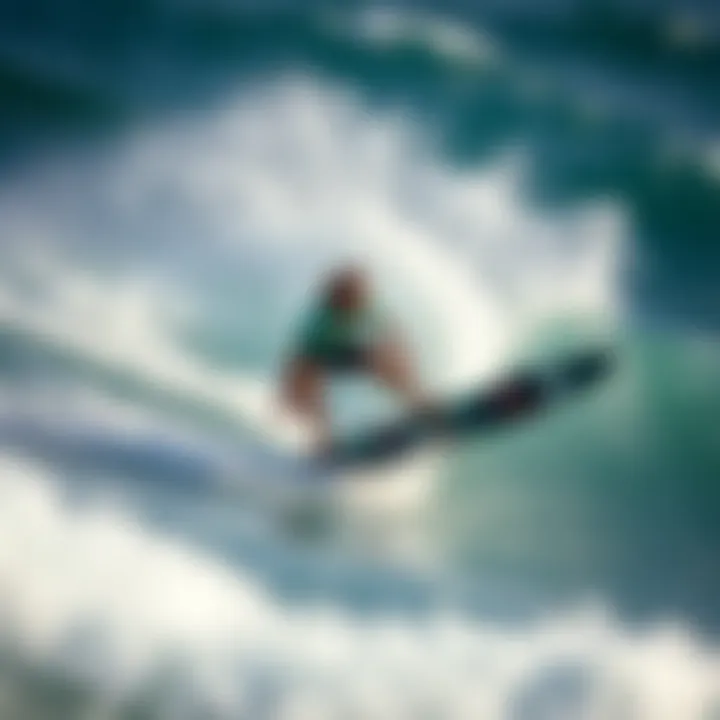
Riding hydrofoils requires a more nuanced approach than traditional boards. It's like learning to ride a bike again but with the added complexity of balance and weight distribution with the foil below you. Here are some key techniques:
- Body Positioning: Keeping your body low and centered over the board is vital. Position your feet evenly apart, distributing weight equally to maintain balance. Bend your knees slightly to allow your body to absorb movements while you ride the waves.
- Control the Kite: Your kite's positioning plays a crucial role in maintaining lift and speed. Keep the kite at around 45 degrees to the horizon for optimal power. A steady pull can help lift the board out of the water, enabling you to glide smoothly.
- Shift Weight for Lift: When preparing to take off, shift your weight back slightly. This action helps raise the hydrofoil out of the water. As you gain speed, gradually bring your weight forward to maintain lift and prevent the nose from diving into the water.
Practicing these techniques consistently will yield significant improvements in your ability to maneuver on a hydrofoil.
Tuning and Adjustments
Tuning your hydrofoil setup can drastically enhance performance. Each rider may have different preferences, so understanding what adjustments to make is essential. Here are some points to consider:
- Adjusting the Foil Angle: The angle of your hydrofoil can impact your ride quality. A lower angle may enhance stability, while a higher angle can offer more speed. Experiment with minor adjustments to find what feels right for your style.
- Fin Setup: The size and shape of the fins also affect control and maneuverability. Smaller fins typically increase speed but can reduce stability. Balance the need for speed with your comfort level regarding control.
- Kite Size: Depending on wind conditions, using a different kite size can change your overall experience on a hydrofoil. In lighter winds, a larger kite may provide the necessary lift and power.
Making these adjustments can help you achieve an optimal riding experience, delivering both performance and control.
Common Mistakes to Avoid
Even with proper techniques and adjustments, beginners often trip over the same hurdles. Avoid these common mistakes to improve your hydrofoil experience:
- Overpowering the Kite: Many riders make the error of flying their kite too aggressively, leading to loss of control. Always fly your kite within its limits, especially during harsh wind conditions.
- Neglecting Foot Placement: Improper foot placement can lead to a loss of balance and premature crashes. Keep your feet steady and positioned correctly throughout your ride.
- Not Paying Attention to Wind Conditions: Many enthusiasts underestimate how wind patterns can change swiftly. Being aware of conditions can save you from a precarious situation out on the water.
By steering clear of these mistakes and focusing on enhancing your riding technique, tuning your setup, and staying attentive to conditions, you can experience the thrilling world of flight board hydrofoiling to its fullest.
"In the world of hydrofoiling, it's all about finesse over sheer power."
For further resources and community tips, consider checking out forums like reddit.com/r/kiteboarding or articles on Britannica for valuable insights.
Safety Considerations in Hydrofoiling
When engaging in an adventurous sport like kiteboarding, safety should always be at the forefront of any rider's mind. Hydrofoiling introduces a new layer of excitement and performance, but it also brings unique risks and challenges that need to be addressed. Understanding these considerations is vital for ensuring a safe and enjoyable experience on the water.
Being equipped with the right safety measures will not only protect the rider but will also enhance confidence while navigating unpredictable conditions. Increased speed and height can be exhilarating, yet they demand a greater level of awareness and precaution.
Essential Safety Gear
Having the right safety gear can make a significant difference in both performance and security. Below is a list of essential items every hydrofoiler should consider:
- Helmet: A well-fitting helmet can protect against head injuries in case of falls or collisions, particularly when combining high speeds with aerial tricks.
- Impact Vest: Unlike traditional life jackets, impact vests provide buoyancy while still allowing for mobility. They can cushion the impact from falls and provide additional warmth in cooler waters.
- Wetsuit or Drysuit: Depending on the weather, a wetsuit is important for warmth and overall comfort. A drysuit is even better for extreme conditions, keeping you dry and warm.
- Safety Leash: This device connects the rider to the board, reducing the risk of losing it during falls, which can be crucial in turbulent waters.
- Cutting Tool: A quick cutting tool can be lifeline in emergencies. Whether it’s getting tangled in lines or needing to sever a strap, being able to act quickly is paramount.
By being properly geared up, riders are better equipped to handle mishaps that may occur.
Understanding Hydrodynamic Risks
Hydrodynamic risks in hydrofoiling primarily stem from the nature of foils functioning beneath the water's surface. Here are some significant points to keep in mind:
- Loss of Control: As riders lift off the water, they may experience a loss of control at high speeds, especially if they miscalculate their moves. The board and rider can quickly decouple from the water, leading to sudden falls.
- Environmental Factors: Wind and wave conditions can change on a dime. Hyper-awareness of surroundings is essential; gusts and choppy waters can lead to unexpected crashes.
- Visibility: When engaging in group rides, visibility becomes a safety issue. When riders fly higher, they may not be able to spot those on the water's surface. This necessitates proper distance and communication with fellow riders.
- Foil Design Risks: Different foil designs can react poorly in various conditions. Understanding which foils match your skill level and local water is essential to minimizing the risk of accidents.
Preventative measures alongside understanding these risks will help ensure that hydrofoiling remains an exhilarating yet safe experience ahead. The core of this dynamic sport relies not just on skills but also on respect for the inherent dangers associated with it. The lessons learned from safety measures are invaluable, encouraging a community of responsible and wiser kiteboarders.
“In the realm of speed and thrill, safety becomes the tether that keeps caution and excitement in harmony.”
For additional resources on safety in watersports, you can visit American Sailing Association's Guidelines and engage in community discussions on platforms like Reddit.
Comparative Analysis: Hydrofoils vs. Traditional Boards
When it comes to the realm of kiteboarding, the debate between using hydrofoils versus traditional boards is as lively as a summer breeze on a hot day. This section digs into the nitty-gritty of performance and experience, pitting these two types of gear against each other. By understanding the differences, riders can make informed choices based on their own preferences and goals.
Performance Metrics
In a sport where speed and agility hold high value, performance metrics become critical in guiding a rider's choice. Hydrofoil boards create lift by utilizing underwater wings that glide above the water surface, which results in striking performance advantages.
- Speed: Riders on hydrofoils often find themselves zipping along like a flash. These boards allow for significantly higher speeds compared to traditional boards. Where a conventional board might cap out in speed or struggle in choppy conditions, a hydrofoil can slice through the water with much finer precision.
- Energy Efficiency: Less drag on a hydrofoil means that riders can maintain speed with less effort. This feature proves beneficial on long outings where conserving energy is essential.
- Riding Experience: When you’re up off the water, chop and waves don’t seem as daunting. Hydrofoils allow riders to float above the surface and ride smoothly, even in conditions that typically cause a bumpy ride on traditional boards.
Traditional boards, on the other hand, have their own set of advantages.
- Stability: They offer stability when riding, especially for beginners. When a rider is learning, the increased surface area can help in maintaining balance.
- Learning Curve: For those just starting out, traditional boards are more forgiving. Riders can hone their skills without the steep learning curve that hydrofoils might present.
User Experience and Skill Levels
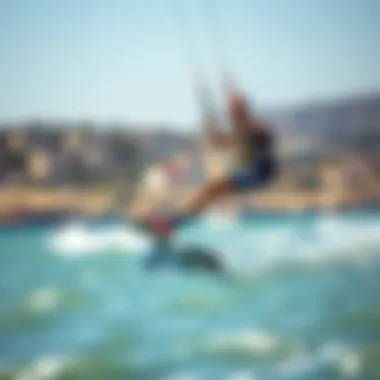
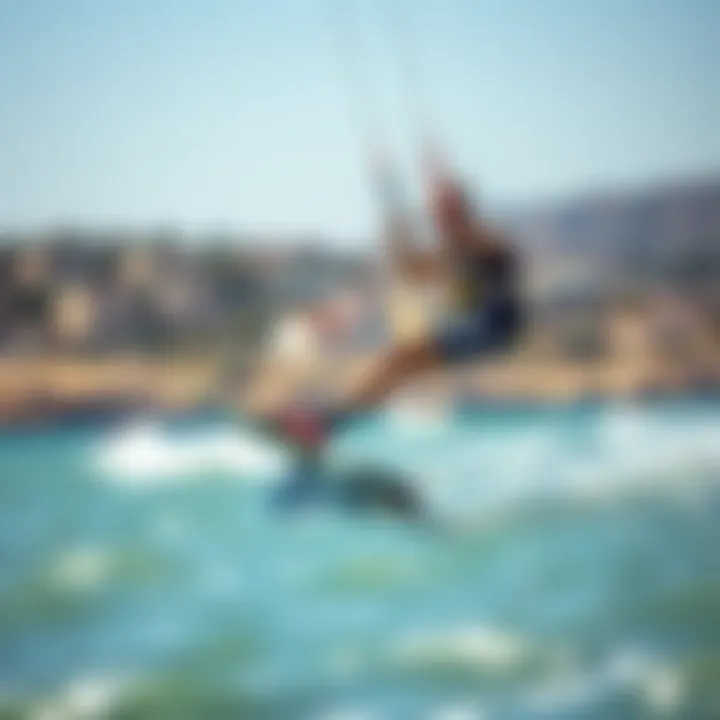
The experience of using either board type can vary significantly, influenced by the rider’s skill level and desired riding style.
- Hydrofoil Experience: Hydrofoiling isn’t just about how you position your body; it’s a blend of finesse, balance, and sensitivity to the movements beneath you. Riders often describe hydrofoiling as feeling weightless, and mastering it often means plenty of practice and patience. Riders adept in hydrofoiling can perform advanced maneuvers that can’t be achieved on traditional boards.
- Traditional Board Experience: For those who prefer a more grounded experience, a traditional board caters to that crowd. Carving turns and jumping can feel more predictable when tethered to the surface. Traditional boards remain popular among a broader audience, making them accessible for recreational users and casual riders.
It's essential to note that these experiences don’t exist in isolation. Riders can flow between both depending on conditions or personal preferences.
In summation, the choice between a hydrofoil and a traditional board affects performance metrics, user experience, and ultimately, the enjoyment of kiteboarding itself. The comparative analysis reveals that each board has its strengths and appeals to different types of riders. The next time you’re on the water, consider what you’re looking for in your ride and what board can help you achieve just that.
Future of Flight Board Hydrofoils
As we look ahead into the realm of kiteboarding, a compelling shift is taking place—one that revolves around the concept of flight board hydrofoils. This isn’t just a fleeting trend; it is poised to redefine the very dynamics of the sport, presenting new opportunities for both novices and seasoned veterans. Understanding the future of flight board hydrofoils goes beyond mere curiosity; it encapsulates technological innovation, rider experience, and environmental considerations that all kiteboarders should be aware of.
Each advancement in hydrofoil technology offers a doorway to enhanced performance. Riders can expect to experience greater control, higher speeds, and improved efficiency, all while enjoying new terrains that once seemed unreachable. As riders navigate the complexities of wind conditions and water surfaces, the advancements in this field will play a crucial role in shaping the kiteboarding experience, leading us to a more exhilarating and accessible way to enjoy the waves.
Technological Advancements
The landscape of flight board hydrofoils is rapidly changing thanks to several cutting-edge technological advancements. These innovations are not only aimed at performance but also at making the sport more approachable and safer for everyone.
- Material Science: New lightweight, durable materials such as carbon fiber and advanced composites are being developed. These materials significantly reduce board weight while increasing strength, allowing for better maneuverability and enhanced liftoff.
- Design Engineering: Modern hydrofoils are being crafted using advanced engineering techniques. Computational Fluid Dynamics (CFD) is now heavily utilized in designing foils that maximize lift and minimize drag. This precision allows for customized applications, catering to various riding styles and preferences, making it adaptable for both freestyle and cruising.
- Smart Technology Integration: The concept of smart hydrofoils is beginning to take off. Incorporating sensors and IoT capabilities can provide real-time data to riders, assisting in fine-tuning their setup based on wind speed, direction, and water conditions. Ultimately, this leads to an enhanced riding experience where adjustments can be made on-the-fly.
Potential Trends and Innovations
As we peer into the crystal ball, a handful of noteworthy trends are emerging in the sphere of flight boards. These innovations can have far-reaching implications for kiteboarding enthusiasts:
- Eco-friendly Designs: With an increasing focus on sustainability, manufacturers are researching eco-friendly materials and production processes. We can expect more sustainable options that not only reduce environmental impact but also might outperform traditional constructions in performance metrics.
- Modular Systems: There’s a growing trend towards modular designs where kiteboarders can easily swap out components like wings, masts, or fuselages to cater to different riding conditions. This level of customization means increased versatility and a more tailored experience for riders.
- Enhanced Community Engagement Platforms: As the sport grows, so does the community around it. Expect to see innovations in digital platforms that facilitate knowledge sharing among kiteboarders. Advanced forums and apps for exchanging tips, tricks, and riding spots will become vital for new and experienced riders alike.
"The future of kiteboarding is not only about flying high but also about connecting and sharing experiences that can elevate the sport for everyone."
Community Insights and Resources
In the realm of kiteboarding, understanding the dynamics of flight board hydrofoils is not just about technical prowess; it’s also about being part of a vibrant community. These insights and resources connect enthusiasts, allowing them to share experiences, fostering a spirit of collaboration that enhances learning and enjoyment. The importance of community cannot be overstated; it serves as a wellspring of information and support, bridging gaps between novices and seasoned riders.
Engaging with the community brings several benefits:
- Knowledge Sharing: Riders often share tips on gear, techniques, and best practices. This real-world experience can provide insights that traditional resources may lack.
- Camaraderie: Kiteboarding can sometimes feel isolating, especially for beginners. Joining forums or local groups fosters friendships and bonds over shared passions.
- Event Participation: Many communities organize kiteboarding events, competitions, and workshops, which serve both as learning opportunities and a platform for showcasing talent.
- Safety Awareness: Community discussions often include safety tips and personal experiences that can prevent accidents and improve overall riding safety.
Finally, the sense of belonging to a broader movement is motivating and helps elevate one's kiteboarding experience. In a sport as dynamic as this, learning from each other is essential, shaping not only individual skills but also the sport’s evolution itself.
Active Forums and Discussions
Engaging in active forums serves as a treasure trove of information for every kiteboarding enthusiast. Here, riders from diverse backgrounds and skill levels converge to discuss various facets of kiteboarding, particularly focusing on flight board hydrofoils. Popular platforms such as Reddit and Facebook Groups offer dedicated spaces where individuals can pose questions, share triumphs, and troubleshoot challenges.
For instance, subreddits dedicated to kiteboarding can provide instant feedback. One might ask about the best hydrofoil for beginners or share the latest modifications on their setup. The diverse opinions and experiences can guide someone to make informed decisions.
Notable forums include:
- Kiteforum.com: A broad discussion platform covering all aspects of kiteboarding, from gear reviews to riding techniques.
- Reddit: Several subreddits like r/Kiteboarding facilitate vibrant discussions and advice sharing.
- Facebook Groups: Local groups often attract members who are enthusiastic about kiteboarding and willing to help newcomers.
Expert Tips and Recommendations
Gleaning advice from seasoned experts can significantly alter one's approach to kiteboarding with hydrofoils. These insights often come from years of hands-on experience and theoretical knowledge, helping both beginners and advanced riders enhance their skills.
Some expert tips include:
- Experiment with Tuning: Tuning your hydrofoil for different weather conditions can drastically influence your speed and control. Don’t hesitate to adjust the foil's angle or your stance based on wind conditions.
- Start Slow: New riders should begin with smaller waves and moderate wind speeds as they familiarize themselves with the dynamics of hydrofoiling.
- Record Your Progress: Keeping a log of sessions, including types of boards used, conditions faced, and performance notes assists in identifying patterns and areas for improvement.
"Hydrofoiling is like learning to dance on water—every move counts. The right guidance can turn a stumble into a smooth glide."
Lastly, consulting resources like related articles on Britannica.com or instructional videos can also bolster understanding. Participating in discussions and seeking expert advice lays the foundation for continuous improvement and enjoyment in kiteboarding. The more connected one feels, the larger the pool of knowledge to draw from.
The End and Final Thoughts
In summation, the integration of flight board hydrofoils into kiteboarding marks a significant leap in water sports, reshaping how enthusiasts engage with the elements and one another. This advanced technology propels riders beyond traditional kiteboarding limits, offering not only superior performance but also a novel way to experience water dynamics. Understanding the mechanics and advantages of hydrofoiling empowers both seasoned practitioners and newcomers alike, fostering a culture of continuous learning and excitement.
Summary of Key Takeaways
- Performance Enhancement: Flight boards unlock new speeds and an exhilarating experience, particularly in lighter winds, allowing riders to conquer water with grace.
- Maneuverability: Hydrofoils offer unmatched turning precision, transforming how riders navigate and perform tricks on the water.
- Safety and Gear Requirements: Properly understanding safety gear and potential risks is crucial, ensuring an enjoyable experience without compromising well-being.
"Hydrofoiling is not just about riding, it’s about transforming your understanding of kiteboarding to redefine what’s possible on the water."
Encouraging Exploration and Growth
The future of kiteboarding is intertwined with the journey into hydrofoiling, and it invites kiteboarders to explore. Experimentation is at the heart of this sport, and as technology evolves, so do the potential adventures awaiting riders. Dive into various techniques, attend local workshops, and exchange experiences with fellow enthusiasts.
Join communities on platforms like Reddit or Facebook groups where valuable tips and insights proliferate. The world of hydrofoiling is vast and ever-changing. Take the plunge—not just into the water, but into an ongoing quest for knowledge and skill expansion. Whether you are a casual rider, an instructor, or an avid adventurer, there's always a deeper depth to explore.



